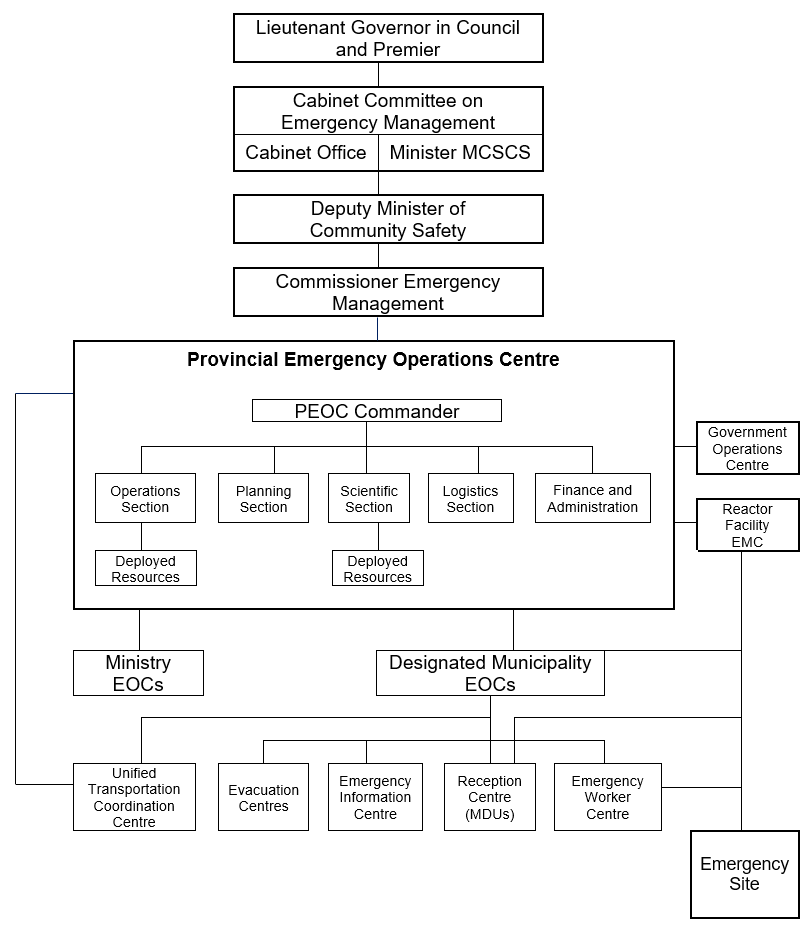Chapter 3 Emergency response organization and facilities
3.1 Emergency Response Organization
3.1.1 The provincial Emergency Response Organization for managing a nuclear emergency at Bruce Nuclear Generating Station is shown in Figure 3.1 and detailed in the PNERP Master Plan, Chapter 4.
3.1.2 Liaison arrangements
- To ensure liaison and coordination between different elements of the Emergency Response Organization, the following arrangements and agreements shall be made:
- Each federal department and provincial ministry with a role in the emergency response to provide a representative to join the PEOC.
- The BNGS operator to provide:
- a liaison officer to the Municipal EOC (see Paragraph 3.1.2 b) below for functions)
- a corporate liaison representative to join the PEOC Operations Group
- a technical support staff to support the PEOC Nuclear Incident Group (NIG) if requested and resources are available
- Provincial staff to be deployed to join the Municipal Emergency Operations Centres (EOCs).
- The role of the BNGS operator liaison officer at the Municipal EOC is to act as a link to the station in respect of the following types of issues:
- BNGS operator support to the Municipalities, e.g., Monitoring and Decontamination Units and Emergency Worker Centres.
- Requests for mutual assistance (e.g., for additional personal monitoring resources, potassium iodine tablets, fire or paramedic services at Bruce Nuclear Generating Station etc.).
- Coordination of the evacuation of non-essential station staff, and of the movement of essential staff to and from the site.
- Facilitating the work of the off-site field monitoring teams.
- Providing situational updates related to the emergency at the reactor facility.
- Providing technical briefings to the Municipal EOC staff in order to clarify the context within which the operational situation may be understood.
3.1.3 Unified Transportation Coordination Centre (UTCC)
A UTCC shall be set up and staffed for a BNGS emergency to implement the UTMP upon notification of either a partial or full activation response by the province.
3.1.4 Provincial ministry offices
The following regional, district and area offices of provincial ministries shall be prepared to respond to the emergency and provide the necessary assistance to the Designated Municipalities, as required by the PNERP Master Plan, Annex I and detailed in municipal plans or, as directed by their respective ministries:
- Agriculture, Food and Rural Affairs - Clinton Office
- Children, Community and Social Services - Southwest Region Office
- Community Safety and Correctional Services, OPP - Western Region
- Environment, Conservation and Parks - Southwestern Region Office and Owen Sound Area Office
- Labour - Western Region, Hamilton and Radiation Protection Services, Toronto
- Municipal Affairs and Housing - Municipal Services Office, Western Region
- Natural Resources and Forestry- Aurora District
- Transportation - Central Region, West Region and the Emergency Management and Planning Office
3.1.5 Designated Municipality Organization
Emergency plans for the Designated Municipalities (Municipality of Kincardine and Town of Saugeen Shores) shall describe their municipal emergency response organizations and its activation.
3.2 Contingency provisions
3.2.1 The PEOC Commander issues operational directives to the emergency management and response organization through the centres in the tier below (see Figure 3.1). However, if for any reason, any of these centres is not functioning or is not responsive, the PEOC Commander may issue operational directives directly to any other element of the emergency management and response organization.
3.2.2 Similarly, response organizations are responsible for taking appropriate actions according to their respective plans, procedures and the requirements of the situation.
3.3 Municipal emergency facilities
- Municipal nuclear emergency plans shall identify the location of the following emergency facilities and shall include provisions for their selection, staffing and resourcing:
- Reception Centres
- Evacuation Centres
- Monitoring and decontamination for evacuees may be accomplished either in a Reception Centre or may be set up separately
- Emergency Worker Centres (EWC). EWC locations should also be able to accommodate a command post for environmental monitoring operations of the Environmental Radiation and Assurance Monitoring Group (ERAMG)
- Emergency Information Centre
- Municipal nuclear emergency plans shall also identify the location of alternate Municipal emergency facilities outside the CPZ.
3.4 Telecommunications
3.4.1 All stakeholder emergency plans shall describe how their emergency centres and facilities are linked via primary and backup communication systems which enable email and transfer of emergency information.
3.4.2 The BNGS operator shall establish primary and backup communications between its Emergency Management Centre (EMC) and the following centres:
- Provincial Emergency Operations Centre (PEOC)
- Bruce Nuclear Generating Station (BNGS)
- Municipal Emergency Operations Centres (EOCs)
3.4.3 All organizations and agencies involved in responding to a BNGS nuclear emergency shall ensure the availability of backup telecommunications systems.
